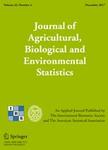版权所有:内蒙古大学图书馆 技术提供:维普资讯• 智图
内蒙古自治区呼和浩特市赛罕区大学西街235号 邮编: 010021

作者机构:Iowa State Univ Dept Stat Ames IA 50011 USA
出 版 物:《JOURNAL OF AGRICULTURAL BIOLOGICAL AND ENVIRONMENTAL STATISTICS》 (农业、生物与环境统计学杂志)
年 卷 期:2014年第19卷第4期
页 面:453-471页
核心收录:
学科分类:0710[理学-生物学] 12[管理学] 0202[经济学-应用经济学] 02[经济学] 1203[管理学-农林经济管理] 020205[经济学-产业经济学] 0714[理学-统计学(可授理学、经济学学位)]
主 题:Presettlement vegetation data (PLSS) Bivariate binary data Centered autologistic models Spatial dependence Conditional autoregressive (CAR) model Markov random field (MRF) Spatial regression for binary data Discrete index random field
摘 要:Spatially structured discrete data arise in diverse areas of application, such as forestry, epidemiology, or soil sciences. Data from several binary variables are often collected at each location. Variation in distributional properties across the spatial domain is of interest. The specific application that motivates our work involves characterizing historical distributions of two species of Oak in the Driftless Area in the Midwestern United States. Scientists are interested in understanding the patterns of interaction between species, as well as their relationships to spatial covariates. Accounting for spatial dependence is not only of inherent interest but also reduces prediction mean squared error, and is necessary for obtaining appropriate measures of uncertainty (i.e., standard errors and confidence intervals). To address the needs of the application, we introduce a centered bivariate autologistic model, which accounts for the statistical dependence in two response variables simultaneously, for the association between them and for the effect of spatial covariates. The model proposed here offers a relatively stable large-scale model structure, with model parameters which can be interpreted in the usual sense across levels of dependence. Since the model allows for separate dependence parameters for each variable, it offers, in essence, the equivalent of a model with a non-separable covariance function. The flexible model framework permits straightforward generalizations to structures with more than two variables, a temporal component, or an irregular lattice domain. Supplementary materials accompanying this paper appear on-line.